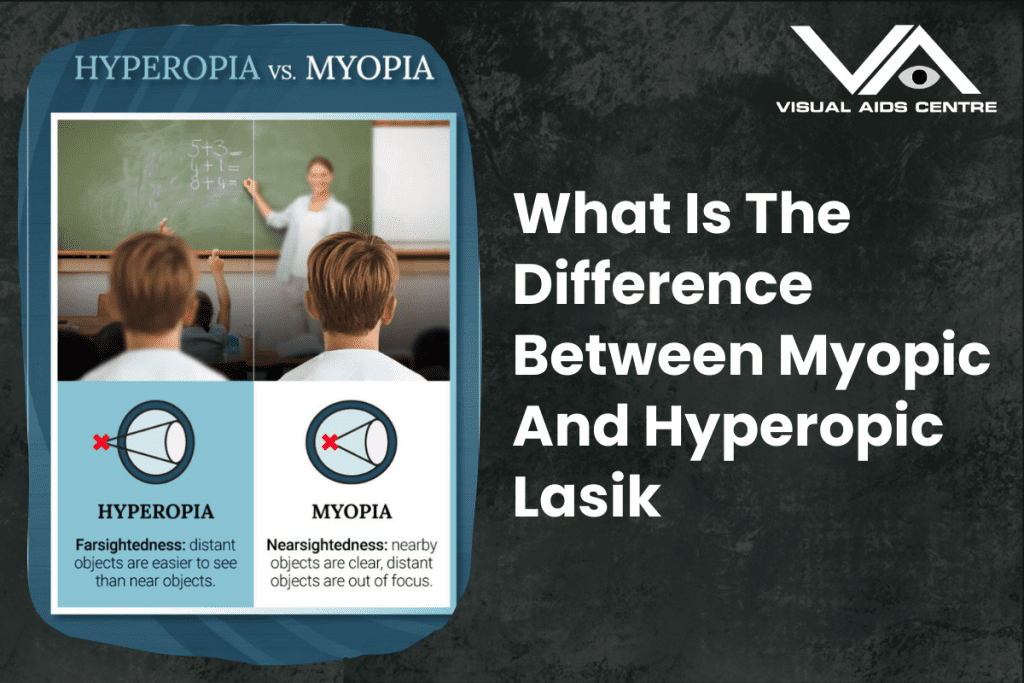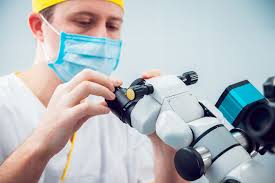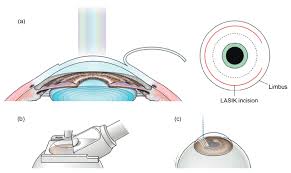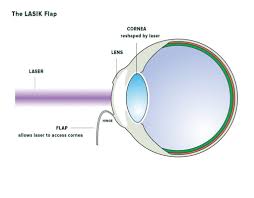Table of Contents
ToggleThe difference between myopic and hyperopic LASIK lies in their vision correction. Myopic LASIK corrects nearsightedness, while hyperopic LASIK fixes farsightedness.
Both treatments are designed to enhance vision by reshaping the cornea, allowing light to focus properly on the retina.
Below, we’ll break down these procedures, their purposes, and their key differences so you can better understand which might be the right option for you.

What is Myopic LASIK?
Myopic LASIK is specifically designed to correct myopia, commonly referred to as nearsightedness. If you have myopia, you experience difficulty seeing objects at a distance, but nearby objects remain clear. This condition occurs because the eye is too long or the cornea is too steep, causing light to focus in front of the retina instead of on it.
How Myopic LASIK Works?
Myopic LASIK involves using an excimer laser to reshape the cornea by flattening its steep curvature. This adjustment allows light to focus directly on the retina, providing clearer distance vision.
Key Benefits of Myopic LASIK:
- Improved distance vision
- Reduced or eliminated dependency on corrective lenses
- A quick procedure with a recovery time of only a few days
Who is it for?
Candidates for myopic LASIK are typically those with mild to moderate myopia, stable vision, and healthy corneas.
What is Hyperopic LASIK?
Hyperopic LASIK is designed to correct hyperopia or farsightedness. This condition makes nearby objects appear blurry while distant objects remain clear. Hyperopia occurs because the eye is too short or the cornea is too flat, leading light to focus behind the retina.
How Hyperopic LASIK Works?
Hyperopic LASIK reshapes the cornea by steepening its curve. This helps light focus properly on the retina, improving the ability to see nearby objects more clearly.
Key Benefits of Hyperopic LASIK:
- Enhanced near and intermediate vision
- Reduced reliance on reading glasses or contact lenses
- Suitable for addressing mild to moderate farsightedness
Who is it for?
Candidates for hyperopic LASIK must meet specific criteria, including stable vision and no presence of eye diseases like glaucoma or cataracts.
Myopic LASIK vs Hyperopic LASIK
Although both procedures use similar methods, their goals differ based on the type of vision correction needed. Below is a detailed comparison:
| Aspect | Myopic LASIK | Hyperopic LASIK |
| Condition Treated | Nearsightedness (myopia) | Farsightedness (hyperopia) |
| Corneal Adjustment | Flattens the cornea to reduce curvature | Steepens the cornea to improve curvature |
| Vision Impact | Improves distance vision | Enhances near and intermediate vision |
| Required Vision Profile | Requires stable, mild to moderate myopia | Requires stable, mild to moderate hyperopia |
| Surgery Duration | Approximately 10-15 minutes per eye | Approximately 10-15 minutes per eye |
| Recovery Time | 2-3 days for most standard activities | 2-3 days for most standard activities |
| Ideal Candidates | People up to mid-40s with stable vision | People up to mid-40s with stable vision |
Key Distinction:
The fundamental difference between the two lies in the corneal reshaping required to address opposite refractive issues.
What Are the Similarities Between the Procedures?
Despite their differences, myopic and hyperopic LASIK share several similarities:
1. Underlying Technology
Both use an excimer laser to reshape the cornea. This enables precision and minimises damage to surrounding tissues.
2. Quick and Minimally-Invasive
The procedures are completed in under 30 minutes for both eyes, and patients often experience vision improvement within 24 hours.
3. Permanent Results
Results from both surgeries are lasting, often providing years of improved vision with no need for repeat treatments.
4. Suitability Requirements
Both surgeries require assessment by an ophthalmologist to ensure you meet criteria like sufficient corneal thickness and general eye health.
5. Painless Experience
Numbing eye drops are applied to ensure a painless process, though some may experience mild discomfort during recovery.
6. Enhances Quality of Life
Both procedures aim to reduce dependence on glasses or contact lenses, offering greater convenience and confidence.
Choosing Between the Two
Your choice between myopic and hyperopic LASIK ultimately depends on your refractive error.
- If distant objects appear blurry, myopic LASIK is the solution.
- If close objects are unclear, hyperopic LASIK will address your needs.
Additional Factors to Consider:
- A comprehensive eye examination will determine your eligibility.
- For people with mixed refractive errors (e.g., presbyopia or astigmatism), alternative LASIK treatments like multifocal LASIK or PRK may be explored.
Your ophthalmologist is the best resource to help tailor treatment to your specific needs.
Possible Risks and Side Effects
Although LASIK is an advanced and safe procedure, it’s important to be aware of potential side effects:
- Dry Eyes: Temporary dryness is common and usually resolves with eye drops.
- Halos and Glare: Some patients experience halos or glare at night, though this is temporary.
- Undercorrections or Overcorrections: Rare and generally adjusted through enhancements.
- Eye Infections: Extremely rare due to sterile conditions during the surgery.
To minimise risks, consult with an experienced eye surgeon and adhere to post-operative care instructions.
The Future of LASIK Technology
With advancements in AI and precision imaging, LASIK techniques are constantly improving. Innovations like wavefront-guided LASIK and topography-guided LASIK enable even more personalised treatments for myopic and hyperopic patients. These tailored approaches offer improved accuracy, fewer side effects, and enhanced recovery times.
Patients now also benefit from technological improvements such as automated flap creators and real-time eye-tracking systems.
Expect LASIK to continue evolving, particularly with its growing popularity in correcting mixed refractive errors.
Final Thoughts
Understanding the difference between myopic and hyperopic LASIK is crucial for those considering vision correction. Myopic LASIK flattens the cornea to improve distance vision, while hyperopic LASIK steepens it to enhance near vision.
Both procedures are highly effective at delivering improved clarity and reducing dependency on glasses or contact lenses. Before making your choice, consult an eye specialist who can assess your unique needs and determine the best course of action.
If you’re ready to take the first step towards clearer vision, speak to your ophthalmologist today for a tailored recommendation!













